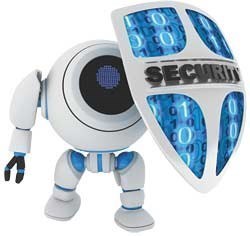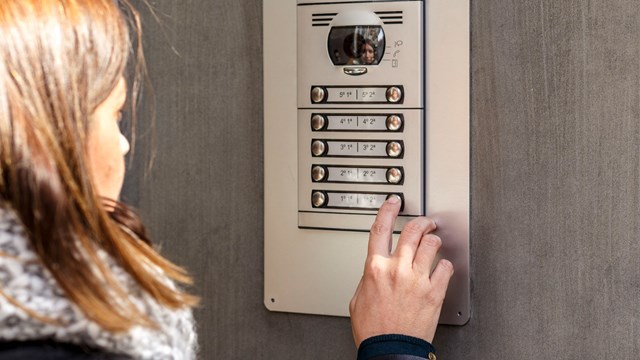
It’s not surprising that residents are more willing to invest in security for their home sweet home than they might be for other expenditures. Even in today’s difficult economy, providers say there’s little disagreement about choosing the latest and the greatest system—live or alarmed—that associations can afford.
High-end technology is popular, within reason. The manager of an urban complex of multifamily buildings, set in a challenging environment, has far different concerns than the person responsible for safety in a suburban enclave of single or attached residences, so security depends upon a variety of issues. Providers need to establish the most cost-effective combination of security measures at each location, balancing resident preferences with safety.
These days, in-home cameras monitor activity, and phones control entries, lights and appliances. It’s easy to look like you’re home when you’re not. But how do managers decide which technology works best for the entire area? There are no rules—deciding takes consultation with experts, site inspection and discussion with residents.
Delay Doesn’t Pay
Robert Kravets, president of Realty Corp. of Boston, says waiting until there’s an incident, possibly serious, is not the way to start. Most properties don’t need major security beyond door locks, lights, etc., but there are exceptions. “We have one property that’s extremely security-conscious; they have all kinds of (electronic) stuff and have for 30 years. We’ve had security evaluations done by security people, alarm companies. They used to have incidents there all the time, and they haven’t had them for a really long time now. That’s partially because the makeup of the area around the property changed, and because we have a tight system there.”
These clients initially thought technology would replace the cost of live security personnel. “After seven years, it turned out it could not be done,” Kravets says. People depend upon security guards to be there, regardless. “They want another person around to run and check things out. You need someone to say ‘Help is on the way,’ or keep them warm from trauma. You can’t do that through surveillance.”
There are start-up costs to consider. In the short term, conversion is expensive, with a five- to seven-year payback. “That is normally OK, but in this environment, people are not willing to look at that,” Kravets says.
Tech-savvy personnel also cost more to hire. Picture the setup in a complex system with multiple screens and cameras that stop and focus on anything suspicious while the others keep going. That’s not a situation for a condo with doormen or guards who are expected to act as delivery men. “The cameras are going ‘dit-dit-dit’ and there’s lots to do,” Kravets says. “We face its limitations all the time at our locations.”
Often, a simple surveillance system does the job, he says. “If they see the cameras, and the warnings of 24-hour surveillance, and they see people around, they’ll go someplace else.” By the way, Kravets warns against using dummy cameras. “That’s false security,” he says, “and a lawsuit waiting to happen.” (See sidebar)
Working Hand in Hand
Ralph Sevinor, president of Wayne Alarm Home Security, Lynn, Massachusetts, also says people and machines are interdependent.
“Technology changes constantly,” he says. “A software- and hardware-driven device brings complications at times. And problems result when there is a changeover—through user error, which accounts for most problems with these systems. “There is a learning curve each time there’s a conversion.” But the systems are tested—in actual use situations—before they become available to customers, so that glitches are commonly worked out ahead of time.
The use of biometrics, such as fingerprint or facial recognition systems, is more common in corporate settings, but may migrate. “Facial recognition systems are being added. These came out of the military. Instead of using a card or a key, some systems are designed to recognize who you are as you approach, linking your face to the database.” With this system, people can’t loan a card to someone else, either. “And the system can identify that someone is with you, and it will automatically ask questions (to identify the situation).”
Can voice recognition be far behind? Probably not. One might think elderly residents would balk at this as a privacy intrusion, but it’s quite the opposite. “Interestingly, they are installed at some of the elderly complexes as well,” Sevinor says. “You’d think they’d be the last ones to want to embrace a new technology; some people just want a metal key in their hand.” Not so for some seniors.
Another new technology, an anti-passback system, prevents people from propping open doors to bypass the security system. The system will sound an alarm when that occurs.
“One thing that’s new allows a resident to pick up a telephone handset when leaving the premises, and identify him- or herself and give the cell phone number as he or she leaves. What happens next is you have a camera trained on you as you go to your car, to ensure that you’re OK. If (you don’t respond), it will call someone—a guard, immediately, or the police.”
“Technology is taking some leaps and bounds, he says, giving residents many options for protection,” Sevinor says. It’s no longer security just for entering or leaving the premises, it’s also security at home.”
People are integrating the systems for other purposes. “Say, for example, UPS delivers a package and pulls the doorbell. They leave a package. The alarm system takes an automatic video, which captures 10 seconds of it and transfers this to your PDA (cell phone). So you know something’s there before you get home.”
“We have a more mobile society now, so they’re more open to that. And, since 9/11, we have a whole new generation of people using smart phones for information.”
No Substitute for Humans
Technology doesn’t necessarily replace live bodies, Sevinor says. “But where you used to have two or three guards and several entrances, you now have one person acting as a satellite for those other entry locations.”
Protection at main entrances requires the most thought, “because so many people are in and out—residents, workers, etc.,” he says. The company seeks a balance between entrance use and the residents’ desire for security, with success dependent upon education of the residents and work staff. “You can only do so much to keep people out,” he says. “Residents are the next point of defense.”
Greg Sacca, integrated systems consultant for American Alarm & Communications of Newport, Rhode Island , says remote security is growing exponentially. Sacca, based in Arlington, Massachusetts, sees people using phones to control and monitor their systems with phone alarms. “The system is tripped, or it will tell them when someone has disarmed it,” he said. “It will show parents the kid coming in the door after school, or, if he’s having a party with some kids, they’ll know that too.” They can also protect themselves by remotely opening a door for service persons or housecleaners, rather than giving out the security code, and re-alarming it when they leave.
While his firm prefers wired systems, Sacca says wireless equipment is rapidly improving. In larger areas, such as main entrances to condo buildings, a combination of approaches is used. “The entry system can be paired with video so that people can see who is at the door. The system records who’s at the door or in the parking lot.” Carded entry is often included.
The cost of individual home video monitoring equipment ranges from $400 to $1,000, depending on the duties placed on one’s electronic control panel, obtained from an alarm company. There are central monitoring services, infrared cameras, motion detection—prices depend on what one chooses to have and may result in a nominal monthly fee.
There are fewer drawbacks to motion detection, too. Camera equipment has improved considerably. “Twenty years ago, there were a lot of false alarms. Now, it’s very improved, so you don’t get that. There’s been constant improvement in that area; the cameras are better in low light, almost complete darkness.”
High-tech equipment can be the equivalent of someone’s job. “You don’t really need to have a human there,” Sacca says. There is not uniform agreement on this. Residents may prefer live personnel. “If people are used to a concierge type of thing, they would miss that,” he says. “If crime is the issue, then to have an armed guard is better than something electronic, where you would have to rely on a police response.”
Compared to the option of 24-hour human security, cost can be less, depending on the size of the building, and duties. “You’re probably looking at $2,000 to $8,000 (to purchase and install), depending on what you want to do—if it’s just recording, if you need to send the image out to all the units, how big a building it is.” Obviously that requires use of reserves, a special assessment or increased monthly fees until it's paid off. There is also the cost of alarm monitoring, which is again an area that is widely variable in service and pricing.
Dean DaSuta, business development manager at the Boston office of Philadelphia-based Allied Barton Security Service Inc., looks at security technology from the point of view of someone whose company provides live security officials to 3,000-plus sites—both commercial and residential; they are trained in the latest technology to assist them in their roles.
“They’re using hand-held iPhones, programmed with different types of software that allows them to conduct tours, do inspections, or write up work orders for maintenance as they’re inspecting, creating a flow of information that is conducive to immediate attention to detail within the property,” DaSuta says.
Very few residential customers use biometric systems. They’re more common on the corporate side, DaSuta says. Quite a few locations use surveillance cameras around the clock, with an officer monitoring. In some locations, live personnel are also checking the premises.
Lara Richardson, vice president of Liability Consultants, Inc. in Boston, says closed-circuit television surveillance has become so common that people no longer resent it overall, but residents resent some high-tech innovations. “We do often see resistance from residents when it comes to control access measures, such as locked doors or gates. Property management will, at times, make concessions on security measures, due in large part to the complaints of residents about the lack of convenience of these measures. Property managers should remember, however, that security is the paramount concern, and residents often easily adapt to the new security measures once they become accustomed to them.”
While she hasn’t encountered any statutes or laws governing the use of high-tech security systems, Richardson says there is a potential legal issue surrounding camera use—when it invades areas that might be considered private.
Overall, people approve of technological surveillance for safety, especially if it’s for their homes, DaSuta says. “People get it, when it comes to spending money on their home security, whether it be technology or more man hours. People want to be as smart as they can be when it’s their needs.” He disagrees with any assumption that an all-tech protection system is sufficient. Some evidence of that comes from last summer’s floods in New England and the East Coast. Trained security officials stepped in to help. “They were ready to go into a completely different mode when a natural disaster struck … with hurricane evacuation drills, disaster recovery plans for physical assets and intellectual property,” he said. “The client expects their property to be safe and secure, and we’re there to provide that; you do what you’ve got to do to ensure it.”
Ann Connery Frantz is a Massachusetts freelance writer and a frequent contributor to New England Condominium.






Leave a Comment